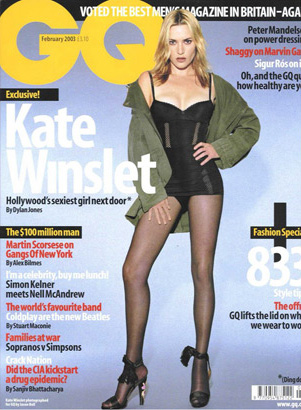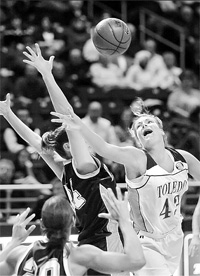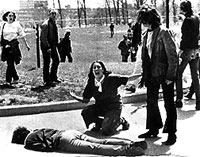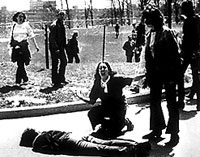Altering photos is as old as the medium. An excellent online survey, Photo tampering throughout history, compiled by Hany Farid, a professor at Dartmouth, shows the highlights of this duplicitous art -- from Abe Lincoln's head composited onto John Calhoun's body to a cover of Star magazine that shows Brad & Angelina together on separate beaches in the Caribbean & Virginia.
Nowhere is manipulation more prevalent than in the routine "slimming" of female celebrities & models for newspapers, magazines & fashion catalogs.

"Kate Winslet, cover of GQ Magazine"
As a man who frankly loves to look at women's grown-up bodies, I find this freakish fashion of squeezing & elongating models completely mystifying. It makes them look sick, brittle, machinelike -- surely the opposite of sexy. To her credit, Kate Winslett was not amused by the (relatively mild) treatment shown above. ""I don't look like that and more importantly I don't desire to look like that," she said. "I can tell you that they've reduced the size of my legs by about a third".
Anyone who has witnessed the mental & physical tortures of anorexia wants to murder the people who create such images. But the general public -- especially the males -- tends to look at such alterations with bemusement -- sort of "Hey, it's crazy, but, after all, it's not supposed to be true."
In fact, most of the shocked outrage & swift justice seems reserved for those who dare to modify the sacred truth of news photographs. Newspaper & magazine pictures, routinely color-corrected, cropped, brightened, darkened & sharpened for years, are now suddenly seen as threatened by digital alteration. It has been the custom for the past few years to fire & shun as pariahs news shooters who alter pixels in any way . To get into this kind of trouble, young, ambitious photographers usually add, remove or rearrange elements to improve a picture's composition. They learned this in school as a way to increase graphic impact, & they want their work noticed.

Photo by Allan Dietrich, cited as a breach of photojournalistic ethics (the ball was added).
Instead of inspiring empathy, this ambition seems to bring out the high school vice principal in news managers and executives. To explain the 2007 firing of staff photographer Allan Dietrich, for instance, Toledo Blade editor Ron Roybach said "... the changes Mr. Detrich made included erasing people, tree limbs, utility poles, electrical wires, electrical outlets, and other background elements from photographs. In other cases, he added elements such as tree branches and shrubbery ... "Readers have asked us why this was such a big deal. What's wrong with changing the content of a photograph that is published in a newspaper? The answer is simple: It is dishonest. Journalism, whether by using words or pictures, must be an accurate representation of the truth."
Putting aside my sympathy for the photographer, I don't disagree with this. Not at all, though I might substitute the word "aspire to" for "be" in the last sentence. But I'm interested in the self-righteous tone of the denunciation. I've noticed the same tone in other journalistic ethics scandals we've had in recent years. Absolutist declarations that, without much conviction, seek to return -- at least rhetorically -- to values that never really held sway. I think perhaps it's the presto-chango ease of photoshop alteration that makes these warnings so dire, even a bit hysterical.
Rally round the Truth, the techno-witches are here!
What is everybody so afraid of? Re Dietrich, OK, fire the guy -- there's an important principle here & he broke the rules. -- but erasing electrical outlets in pictures doesn't actually mean the barbarians are at the gates, does it? Maybe Dietrich just needs to work in a different part of the photo business, one where fictional creativity is encouraged.
It turns out that photo editors for news outlets weren't always so fussy.

"Kent State," John Filo (published photo)
This 1970 photo by John Filo won a Pulitzer Prize. It shows Mary Ann Vecchio screaming as she kneels over the body of student Jeffrey Miller at Kent State University, where National Guardsmen had fired into a crowd of demonstrators against the Vietnam War, killing four and wounding nine. It's an iconic picture, unforgettable to a whole generation.

"Kent State," John Filo (unretouched photo, 1st published 1995)
Who knew that the photo we looked at in Time Magazine in 1970 had been retouched to remove a fence post that appears to be sticking out of Vecchio's head? And crudely retouched too (airbrushed; no photoshop then, remember). This wasn't discovered until 1995.
TO BE CONTINUED
4 comments:
I go to a gym. Rarely do I see a perfect body (on either men or women). That photo of Kate Winslet - I thought was Madonna at first glance! (someone who is SERIOUSLY underweight and over-muscled!) So it's good to know we are not crazy when we question what we are looking at. And Kate always speaks out. But why does she pose in such a stupid outfit for such ridiculous cover photos in the first place?! How embarrassing for an intelligent actress to have to do this to stay in the biz! Why don't they just say no???
Kids (e.g. teens) are well aware of the media influence. I taught a health class this spring (yeah, out of license boo-hoo) and it's no news to them how Hollywood images of thin actresses who smoke and purge to stay thin enough to get work affect the self-image of youth. We had Twiggy - and I was dying to be thin, blonde, and English - which is hard for the typical kid of unsullied southern Italian (Sicilian and Neapolitan) heritage - GOOD LUCK! lol
"Toledo Blade editor Ron Roybach said "... the changes Mr. Detrich made included erasing people, tree limbs, utility poles, electrical wires, electrical outlets, and other background elements from photographs. In other cases, he added elements such as tree branches and shrubbery ... "Readers have asked us why this was such a big deal. What's wrong with changing the content of a photograph that is published in a newspaper? The answer is simple: It is dishonest. Journalism, whether by using words or pictures, must be an accurate representation of the truth."
Well the "Toledo Blade" is a rarity in journalism. Recently The Philippine Daily Inquirer on their web site wrote an introduction to a review I posted on The Expat that said almost the exact opposite of what the review said. How they changed things can be seen at http://auspat.blogspot.com/2008/06/inquirer-vandalizes-review.html
Anything in the "news" should be taken with a large dose of salt, words or pictures.
Catt -- Thanks. Yeah, Twiggy, who could forget Twiggy? (you youngsters might have to google).
Expat -- you said, 'Anything in the "news" should be taken with a large dose of salt, words or pictures.' I say, Amen.
As mentioned in the article, the Toledo Blade fired a very talented photographer for digitally manipulating photos... A year and a half later 8/25/08 they published one of the worst digitally manipulated photos ever... On the front page. Now I begin to wonder, is it the photographer or the newspaper?
http://www.toledoblade.com/apps/pbcs.dll/misc?url=/templates/zoom.pbs&Site=TO&Date=20080825&Category=NEWS32&ArtNo=106232154&Ref=AR
Post a Comment